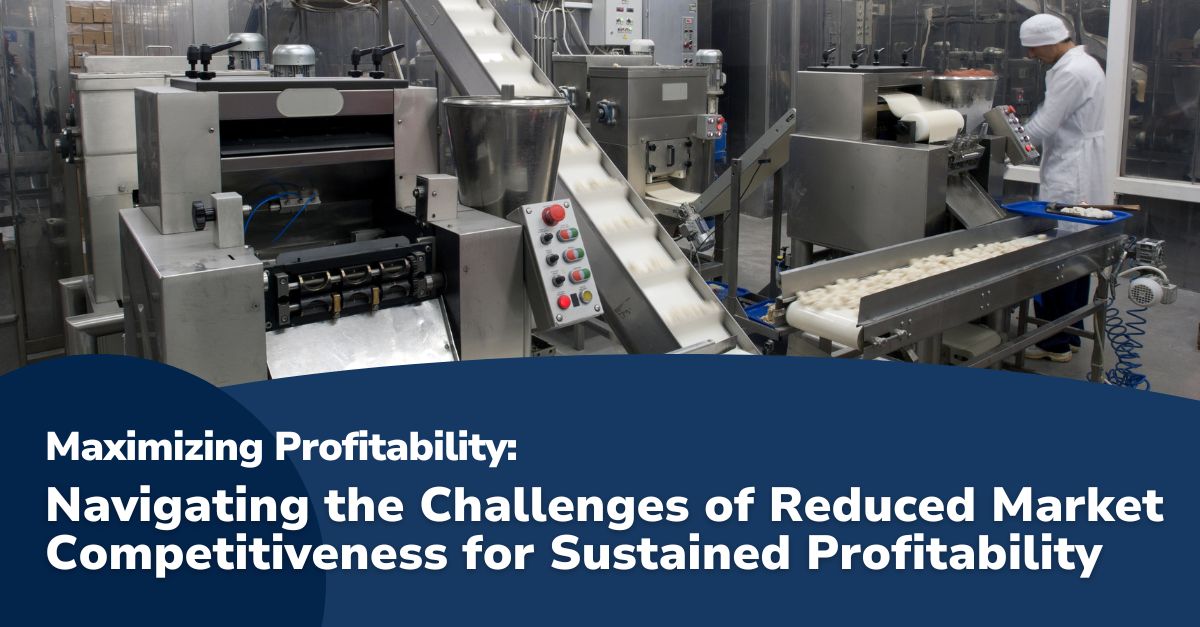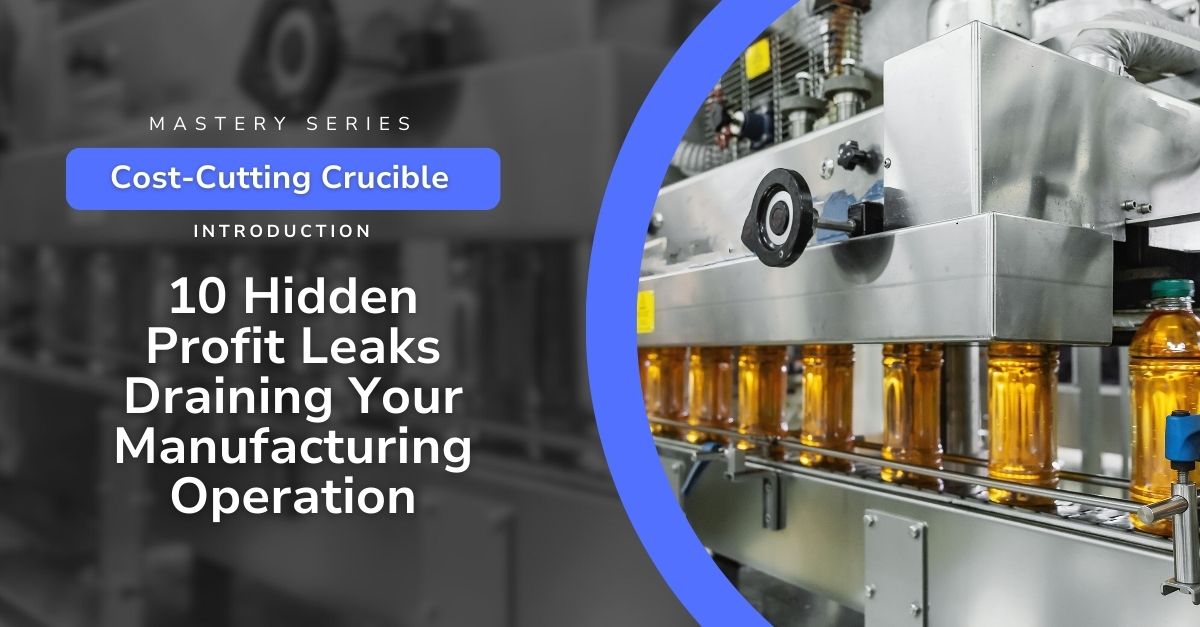
In manufacturing, staying competitive is not just about getting ahead of rivals. It is about ensuring your company has the strength to survive market shifts, maintain customer trust, and consistently turn a profit.
When competitiveness slips, the impact is rarely isolated. It tends to hit on multiple fronts at once, from falling margins to talent shortages, and these effects can build into bigger operational problems if they are not addressed quickly.
Market competitiveness influences every facet of a business, from its ability to attract and retain customers to its operational efficiencies and innovation capabilities.
A dip in competitiveness can set off a chain reaction, eroding profitability and undermining long-term growth prospects. Recognizing the signs of reduced competitiveness and implementing strategic countermeasures is essential for businesses committed to maintaining their market position and securing their financial future.
This installment explores the top 10 ways reduced market competitiveness can harm or erode profitability. More importantly, it provides actionable mitigation strategies for each challenge, designed to bolster competitiveness and drive sustained profitability. From enhancing product innovation to diversifying customer bases and strengthening supply chain resilience, the strategies outlined here are tailored to help businesses navigate the complexities of today’s market dynamics.
Let’s explore how businesses can turn the tide on reduced market competitiveness, ensuring their place in the market is maintained and strengthened in the face of evolving challenges.
1Declining Market Relevance :
Negative Impact: In manufacturing, relevance is earned by staying in step with what customers want and expect. That could mean aligning with industry standards, adopting cleaner production methods, or incorporating new technologies into your products. When companies fail to adapt, they risk losing buyers to competitors who are more in tune with the market. This loss of relevance can happen faster than many leaders realize, especially in sectors where product lifecycles are short or where environmental and social considerations heavily influence purchasing decisions.
Positive Step: Build systems for constant feedback from the market. Customer surveys, distributor input, competitor benchmarking, and monitoring industry trade shows are all valuable tools. Use the data to update designs, add new features, or adjust pricing models. Consider trial runs of product updates or limited releases to test demand before committing to full-scale changes. The goal is to anticipate the shift, not scramble to catch up after it happens.
2Reduced Pricing Power:
Negative Impact: Once price becomes the primary decision factor for customers, profitability is at risk. Without strong differentiation, companies can be forced into cutting prices just to keep orders, which squeezes margins and makes it harder to invest in productivity improvements or innovation.
Positive Step: Strengthen your value proposition so that customers are buying more than just a product. If your lead times are faster than industry norms, make sure that is known and measurable. If your product outlasts competitors by 20 percent, back that claim with real-world testing data. Develop specialized offerings for niche applications where quality, safety, or compliance are non-negotiable, allowing you to command a premium price.
3Increased Customer Churn:
Negative Impact: High churn means constantly replacing lost business instead of building on existing accounts. In manufacturing, this can show up as buyers switching to overseas suppliers, changing material specifications to work with another vendor, or consolidating suppliers and leaving your company out of the mix.
Positive Step: Treat customer retention as a primary growth driver, not just a sales function. Use CRM systems to track order history, service calls, and feedback so sales and service teams can identify changes in buying patterns. Set regular check-ins with key accounts to address concerns before they escalate. Loyalty incentives such as volume discounts, bundled services, or training programs can create stronger ties that make switching less appealing.
4Reduced Access to Capital:
Negative Impact: A shrinking competitive position often shows up in financial reports. Investors and lenders notice lower market share, slower growth, or reduced margins, and that can make it harder to secure financing for critical projects like equipment upgrades, facility expansions, or R&D initiatives. Without capital, it becomes more difficult to regain lost ground.
Positive Step: Focus on improving your operational efficiency and documenting those gains. If you can show a lender or investor that you cut setup times by 15 percent or reduced scrap by 10 percent, you are making a stronger case for your ability to generate returns. Strategic partnerships can also be a valuable tool, whether that means co-investing in new technology with a supplier or sharing production capacity with another manufacturer to enter a new market.
5Difficulty Attracting Talent:
Negative Impact: A company’s reputation in the market influences its ability to hire. If potential employees see the business as struggling or outdated, they may choose competitors with a stronger reputation for stability, modern facilities, or career growth. Over time, talent gaps can slow production, reduce innovation, and make it harder to meet quality and delivery expectations.
Positive Step: Make your workplace a selling point. Highlight your investment in training programs, automation tools that reduce repetitive tasks, and safety initiatives that protect employees. Promote internal success stories where team members have advanced into leadership roles. Use your existing workforce as ambassadors in recruiting efforts by encouraging them to share their experiences with potential hires.
6Dependence on a Narrow Customer Base:
Negative Impact: Heavy reliance on a small group of customers increases risk. If one major account cuts orders or leaves entirely, the revenue gap can be devastating. This problem is common in manufacturing sectors that rely on a few large OEMs or government contracts.
Positive Step: Expand into new markets where your capabilities match demand. This might include producing components for industries you have not yet served, targeting regional markets you have overlooked, or adapting existing products for different applications. Online sales channels, international trade shows, and targeted marketing campaigns can also help reduce over-reliance on a small customer set.
7Innovation Stagnation:
Negative Impact: Companies under competitive pressure often stop innovating to save costs, but this only accelerates their decline. In manufacturing, failing to introduce new processes, technologies, or product lines leaves you vulnerable to being outpaced by competitors who are willing to invest in forward movement.
Positive Step: Dedicate resources to innovation even during lean times. This can be as simple as running small-scale pilot projects to test new production methods or forming R&D partnerships with suppliers. Offer incentives for employees who bring forward ideas that improve quality, efficiency, or safety. Keep a visible innovation pipeline so teams understand that improvement is part of the company’s long-term vision.
8Supply Chain Vulnerabilities:
Negative Impact: Reduced competitiveness can weaken supplier relationships. Without strong volume or influence, you may face higher prices, less favorable payment terms, and slower response times during shortages. This can lead to production delays, higher costs, and lower customer satisfaction.
Positive Step: Strengthen supplier partnerships by maintaining consistent communication, sharing forecasts, and exploring long-term agreements that benefit both parties. Diversify your supply base to reduce the impact of disruptions, and where possible, develop secondary sources or local suppliers who can provide backup. Supply chain management tools that improve visibility can help you respond faster when problems occur.
9Erosion of Customer Trust and Loyalty:
Negative Impact: In manufacturing, one poor experience can undo years of good service. Late deliveries, quality issues, or poor communication all chip away at trust. Once trust is lost, winning it back is far harder than maintaining it in the first place.
Positive Step: Make reliability a core promise. Track your on-time delivery rate and defect rate, and make those metrics visible to customers. When mistakes happen, address them quickly and communicate openly about the resolution. Build proactive customer service processes that solve issues before they reach a critical point.
10Brand Dilution:
Negative Impact: When competitiveness fades, so does brand strength. A weak brand makes it harder to win new customers, especially in industries where reputation is a major buying factor. This can be particularly damaging in specialized manufacturing sectors where a strong name often opens the door to larger contracts.
Positive Step: Rebuild brand value by showcasing measurable results and customer successes. Invest in marketing efforts that highlight performance data, innovation milestones, and community or industry contributions. Keep brand messaging consistent across every customer touchpoint, from trade shows to digital channels.
Embracing Strategic Transformation for Competitive Advantage
The journey through the complexities of reduced market competitiveness highlights a fundamental business truth: adaptability and strategic foresight are critical to enduring success. As we’ve explored the multifaceted challenges and corresponding strategies in this installment of the Maximizing Profitability Mastery Series, it becomes clear that the path to sustained profitability is paved with continuous innovation, operational excellence, and a deep understanding of market dynamics.
In facing the challenges of reduced market competitiveness, businesses are called upon not merely to react but to anticipate and shape their futures with bold strategic initiatives.
By focusing on differentiation, customer engagement, and efficiency, companies can not only navigate the challenges of today’s competitive landscape but also position themselves as leaders of tomorrow.
As we conclude this exploration, let us remember that the strategies outlined are not one-time fixes but part of an ongoing journey of business improvement and adaptation. The commitment to regularly evaluating and adjusting business practices in response to changing market conditions will ultimately define any enterprise’s success.
Partnering with POWERS for Competitive Excellence
In navigating the intricate landscape of market competitiveness and profitability, the role of a knowledgeable and experienced partner cannot be overstated. POWERS offers a unique blend of expertise, insight, and strategic guidance to elevate your business’s competitive position and profitability. Our approach is rooted in a deep understanding of the industry nuances and our client’s specific challenges in maintaining and enhancing their market competitiveness.
- Bespoke Solutions: At POWERS, we recognize that each business is unique. Our commitment is to provide tailored strategies that address your specific challenges and opportunities, ensuring solutions that are effective and aligned with your business culture and goals.
- Proven Track Record: With years of experience and a portfolio of success stories across various industries, POWERS is positioned to drive significant and lasting improvements in market competitiveness and operational efficiency.
- Collaborative Partnership: We believe in working closely with our clients, engaging your teams, and transferring knowledge to ensure that improvements are deeply embedded and enduring. We aim to empower your organization with the tools and mindset necessary for continuous improvement.
When advanced analytics and real-time performance tracking are needed, we leverage the DPS platform to give manufacturers clear visibility into the operational metrics that matter most. This allows your team to monitor progress, respond quickly to changes, and keep improvement efforts on track long after the initial engagement.
Partnering with POWERS means more than just management consultant services; it’s about building a relationship with a team invested in your success. Our commitment is to walk alongside you in this transformation journey, providing support, guidance, and expertise at every step.
Initiate the transformation of your manufacturing processes, unveiling significant operational efficiencies and cost reductions. Contact POWERS to find out how our knowledge and skills can assist in elevating your company to new heights of excellence. Get in touch with us at +1 678-971-4711 or send an email to info@thepowerscompany.com.
Continue Reading from this Mastery Series
- Part 1 - How Runaway Costs Derail Manufacturers’ Drive for Sustainability
- Part 2 - Tackling Excessive Waste Management Issues in Manufacturing
- Part 3 - Mastering Resource Efficiency in the Quest for Manufacturing Excellence
- Part 4 - The Impact of Unmitigated High Energy Costs on Manufacturers
- Part 5 - How the Complexities of Regulatory Compliance Can Erode Margins
- Part 6 - Navigating the Challenges of Reduced Market Competitiveness for Sustained Profitability
- Part 7 - Don’t Let Preferences Pull You Under
- Part 8 - Low Talent Investment is Undermining Your Bottom Line
- Part 9 - Don’t Let Supply Chain Vulnerabilities Bleed Your Profits
- Part 10 - Outsmart the Competition and Protect Your Profits







